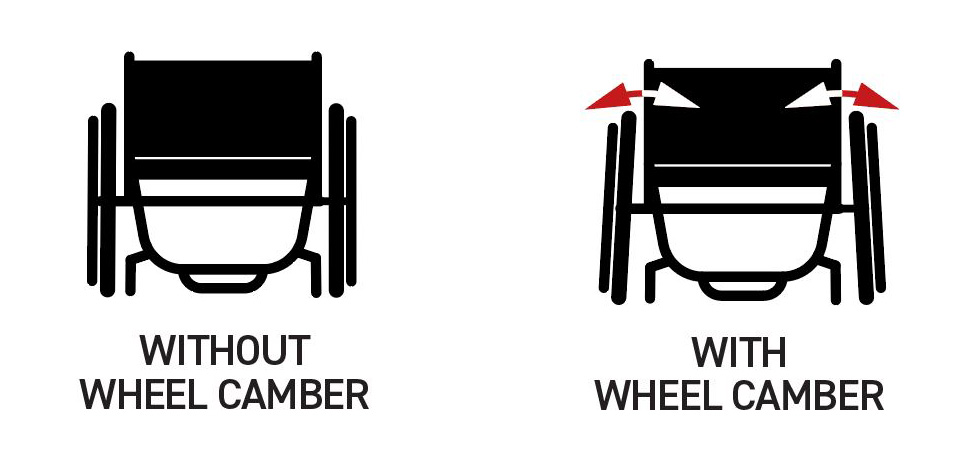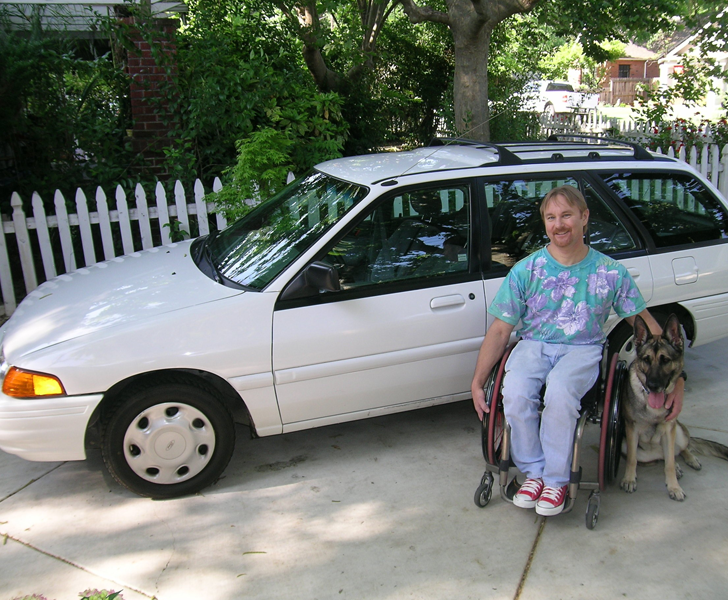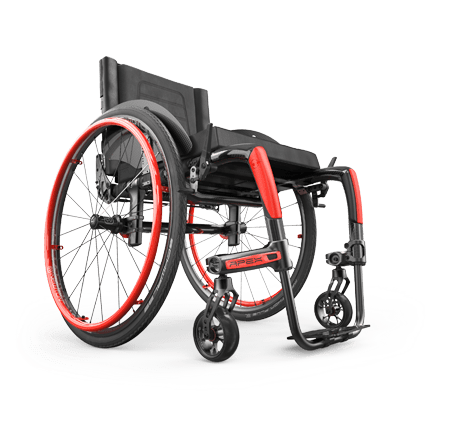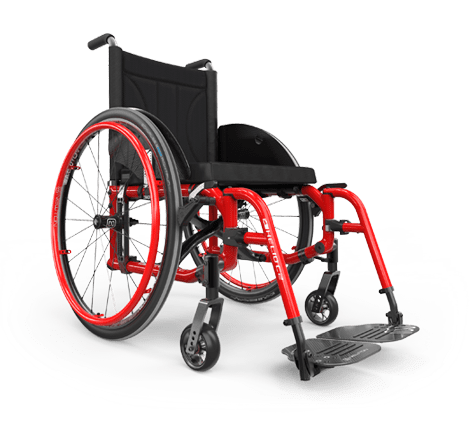Many adjustments can be made to your wheelchair to maximize performance. Camber is one of them; this simple change can help you get further with your energy.
Camber can be a great addition to your wheelchair. But how do you know how much camber is right for you? In this blog, I discuss my experience and explain how I found the right amount of camber for me.
WHAT IS CAMBER?
Camber is the vertical angle of the rear wheels relative to the chair’s frame and is expressed in degrees. At zero degrees camber, the rear wheels are straight up. At two degrees, the top of the wheels are slightly closer to the frame, and the bottom of the wheels are angled slightly outward. This means that the larger the number, the greater the camber angle.

For the average wheeler, the camber performance sweet spot for an everyday chair tends to lie between zero and six degrees with most wheelers running zero to four degrees. Going out to six degrees helps with additional side-to-side stability for activities like camping and pushing on dirt trails. To further understand the technical aspects of camber, be sure to read Alli Speight's (MScOT, ATP) blog on the subject.
Choosing the right amount of camber varies from person to person, and it also changes with experience and age. Below, I will share my experience with camber adjustments, why I made them, and why I changed them.
COOL LOOKS AND SNAPPY TURNS
Let’s admit it: camber looks cool and makes your chair super reactive, allowing you to perform snappy turns, like a Formula 1 car. When I joined the rolling world in 1985 as a T10 para, the ‘in look’ among my rolling peers at the time was to run big camber numbers of six to ten degrees. This presented the wheelchair as being cool, sporty, and made for sharp turns. The possibility of having such a reactive chair is one of the reasons why custom wheelchairs designed for sports such as quad rugby, tennis, and basketball have camber in the 15 to 22 degree range. Shortly after getting my first chair, I increased my camber from two degrees to around eight degrees.
SIDE-TO-SIDE STABILITY
In addition to quick turning, extra camber makes your chair significantly more stable side-to-side because the bottom width of the wheels increases about one inch wider with every two degrees of camber.
MORE EFFICIENT PUSHING
Another benefit of adding camber to your wheelchair is that it tucks the top of the wheels and push-rims in alignment with your shoulders; this gives better leverage and puts less stress on shoulders, elbows, and wrists. I found this to be the case in my early post-SCI-rehab days while I was still trying to rebuild my post-injury atrophied arms and shoulders.
The caveat to extra camber providing more efficient pushing is that it is vital that you adjust the rear wheel toe-in and toe-out, meaning the alignment of the front and back of the wheels. If this is off, tires will rub, which makes it more difficult to push and causes quicker tire wear, more on this later in the blog.

MY EXPERIENCE TRYING DIFFERENT DEGREES OF CAMBER
TOO MUCH CAMBER
Although running big camber numbers makes your chair stable and quick turning, it also makes it wider, which can limit access and cause the bottom of the push rim to thrash walls and doorways. Although I liked the extra stability of 8 degrees of camber, after a while, I found it was much more than I needed.
Those extra 8 degrees of camber added approximately four inches of extra width to my chair. It started to become a problem because the base of my rear wheels was too wide to fit into narrower doorways, and I was frequently rubbing the bottom of my push rims on doorways and walls.
FOUR DEGREES
About a year out from my injury, I lowered my camber to 4 degrees, which still provided quick-turning and a good shoulder pushing angle yet enabled me to fit through doorways and areas that had been too narrow for my chair with an 8 degree camber. For me, 4 degrees of camber also provided enough side-to-side stability for my many outdoor activities like hang gliding, camping, and pushing on trails.
ZERO DEGREES
In the later ‘90s, the ‘look’ for an everyday chair among my peers started to change to ‘the narrowest possible,’ and since my seat width is 14 inches, I opted for zero camber. This enabled me to wheel into extremely tight spaces-like a standard-size bathroom stall.
I enjoyed the tight look and extra accessibility of fitting into tight areas. However, I did notice the narrower wheelbase came at a cost; turns weren’t as snappy, and I would bump my thumbs and fingers on doorways. When you are running two or more degrees of camber, the bottom of the push rim will touch the doorway and not your thumbs and fingers, something I got used to watching out for, but it took a bit of time.
 2005, me and my German Shepherd service dog Schatzie—zero degrees camber on my chair
2005, me and my German Shepherd service dog Schatzie—zero degrees camber on my chair
ZERO DEGREES, BALANCE, AND OSTEOPOROSIS
Another downside I found with zero-degree camber is the chair didn’t have as much extra side-to-side stability that wider camber provided, as my wheelchair skills and balance had been honed by decades of pushing; this wasn’t a problem, that is, until it was a problem.
I’ve always been ‘rough and tumble,’ and an occasional fall out of my chair wasn’t a big deal. Unfortunately, the average person with a complete spinal cord injury develops osteoporosis in their lower extremities within a few years after their injury. At 15-20 years post SCI, our legs can reach the ‘fracture breakpoint’ where a simple fall from a chair can cause a fracture, which is what happened to me. I was hanging out with my brother in his backyard while our young daughters drove around in a battery-powered pink Barbie Jeep. In one of those ‘hold my beer and watch these moments, I decided to hold onto the jeep and get towed around. The little vehicle had more power than I anticipated, and it yanked my chair sideways, spilling me onto the pavement resulting in a broken hip and femur.
TWO DEGREES CAMBER
While I was in the hospital, I decided to change my camber to a more stable two degrees. I’ve been running two degrees of camber for the last 13 years. Based on my ‘survey of one,’ it is the right balance of stability, turning, shoulder position, and narrow width. That’s just me. The correct camber degree will vary from person to person.
 Me with my German Shepherd service dog Killy who is saying hi to his friend Gypsy. Two degrees camber on my APEX C
Me with my German Shepherd service dog Killy who is saying hi to his friend Gypsy. Two degrees camber on my APEX C
WHAT CAMBER IS RIGHT FOR YOU?
Unfortunately, there is no magic answer to which amount of camber is right for you. If you are ordering your first chair, it is important to review this with your clinician. In addition to clinician input, speaking with peers who are experienced wheelers, either in person or at an adaptive sports clinic or one of the many online support groups like United Spinal Association, or type in ‘Virtual Spinal Cord Injury Support Group in your web browser (For Canada, Ontario: Spinal Cord Injury Ontario (SCIO)) as they are good places to get feedback from peers to help you decide on camber angle.
CHANGING CAMBER
The good thing about camber is that it can be changed. Depending on the manufacturer and model of the wheelchair, this may require ordering a new camber tube sized to your specific chair with the camber you want to try. The cool thing about Motion Composites wheelchairs is camber can easily be changed by ordering a set of camber plugs and swapping them out with a few turns of a hex screw and precision adjusted for width by lining up the laser etched marks on each camber plug.
ADJUSTING TOE-IN/TOE-OUT
As mentioned earlier, when running with camber, it is important to adjust the toe-in/toe-out. This is judged by measuring the distance, rim-to-rim at axel height, at the front of your wheels, and back of the wheels. I find the easiest way to do this is to find a box that is approximately rear-axel height. Using a tape measure placed on top of the box and measuring the inside tire-to-tire in front, and then taking the same measurement in the back. Then you adjust the camber tube and/or camber plugs until the distance is the same.
 From left to right: Me, Nikko (Australian Shepherd), Killy (German Shepherd), my daughter Sarah, and Sadie (Australian Shepherd). Two-degrees camber on my APEX C
From left to right: Me, Nikko (Australian Shepherd), Killy (German Shepherd), my daughter Sarah, and Sadie (Australian Shepherd). Two-degrees camber on my APEX C
CONCLUSIONS
So, what is the answer? How much camber is right for you? The answer is simple: the right amount of camber is the one that allows your chair to perform and feel the way that you want it to.
For me, styling around in a properly fitted and adjusted chair is akin to putting on my favorite sneakers in my pre-SCI days. When my chair is set-up just right for me, it feels great and performs the way I want. Spending a bit of extra time on adjustments, including camber can maximize this feeling and your wheelchair propulsion performance.
My advice is to be patient and try different degrees until you feel comfortable. If you are unsure where to start, talking to your therapist will ensure that they give you the best recommendation for your goals and your day-to-day life.
Resources:
Osteoporosis Update: Avoiding the Breaks: https://newmobility.com/osteoporosis-update/
United Spinal Association Peer Support Groups: https://unitedspinal.org/peer-support-groups/










 2005, me and my German Shepherd service dog Schatzie—zero degrees camber on my chair
2005, me and my German Shepherd service dog Schatzie—zero degrees camber on my chair Me with my German Shepherd service dog Killy who is saying hi to his friend Gypsy. Two degrees camber on my APEX C
Me with my German Shepherd service dog Killy who is saying hi to his friend Gypsy. Two degrees camber on my APEX C From left to right: Me, Nikko (Australian Shepherd), Killy (German Shepherd), my daughter Sarah, and Sadie (Australian Shepherd). Two-degrees camber on my APEX C
From left to right: Me, Nikko (Australian Shepherd), Killy (German Shepherd), my daughter Sarah, and Sadie (Australian Shepherd). Two-degrees camber on my APEX C